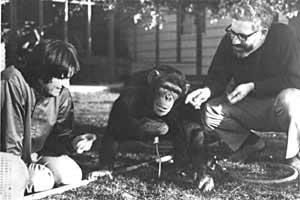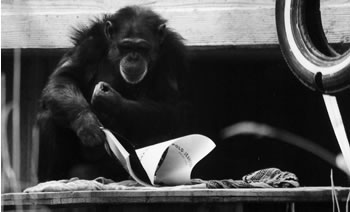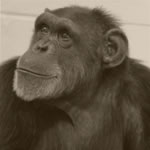Gardner, R. A.
& Gardner, B. T. (1969)
Teaching sign language to a chimpanzee
Background
There have been many attempts at
teaching chimps to use language.
However, some of the earlier attempts were destined to
failure as these studies (e.g. Kellogg and Kellogg 1933) were
attempting to teach chimps to speak and their vocal apparatus is
unsuitable for making speech sounds.
Gardner and Gardner attempted to teach
a chimp to use a non-spoken form of language using American Sign
Language as used by many deaf people in the USA.
It is important firstly to make the
distinction between language and communication as much of the debate
about whether non-humans can use language or not centres on these
definitions of communication and language.
Communication is the process
of transmitting information from one individual or group to another
individual or group.
Animals can certainly communicate with each other. The debate
is about whether they can use something similar to human language to
do this.
Language is a small
number of signals (sounds, letters, gestures) that by themselves are
meaningless, but which can be organised into meaningful combinations
and using certain rules to make an infinite number of
messages.
Aim
The aim
of the study was to demonstrate that a chimpanzee does have the
capability to use human language.
Procedure/Method
The study is a report of the first phase
of a training project (Project Washoe) involving an infant female
chimp called Washoe. It
is a kind of case study whereby detailed records were kept of
Washoe's progress over an extended period of time (32 months).
Unlike most case studies there was no problem the subject had
for which she was receiving help; instead this was a deliberate
attempt to change the subject's behaviour in a particular way in
order to test a hypothesis. The independent variable can be thought of as the training
programme and the dependent variable Washoe's actual use of signs.
The Gardners decided to use a chimp as
a subject for a number of reasons.
The chimpanzee is intelligent, sociable
and capable of strong attachments to human beings.
Although they did recognise that the great strength of the
chimpanzee could cause serious difficulties.
Although earlier studies had failed at
attempting to teach chimps to vocalise like humans, the Gardners
recognised that chimps easily develop hand gestures.
The Gardners decided to use American
Sign Language (ASL) for a number of reasons.
They, of course, recognised the manual dexterity of the
chimpanzee but also chose ASL because of its structural equivalence
to spoken language. They
thought it was also useful because ASL is widely used among deaf
people in North America. This
would allow the Gardners to make comparisons with deaf children.
The Gardners decided they wanted as
young a chimp as was possible in case there was a critical early
stage at which such behaviour had to be acquired.
Because newborn laboratory chimps are very scarce it was
decided to obtain a wild caught infant.
When Washoe (who was named after Washoe
county, the home of the University of Nevada) arrived at the
laboratory in June 1966 she was estimated to be between 8 and 14
months. Because Washoe
was very young when she arrived, she had only a rudimentary hand-eye
control, was only beginning to crawl and slept a great deal.
Therefore little progress could be made for the first few
months.
The Gardners ensured that Washoe had
lots of human companions who all had to master ASL.
The environment was designed to provide maximum stimulation
with as few restrictions as possible.
Washoe was taught mainly using
imitation and operant conditioning.
Operant conditioning is simply reinforcing behaviour which is
desired. The Gardners found that Washoe would learn some signs by
observing and imitating, but often had to "mould" her
hands into the right shapes when they were teaching her new signs.
Behaviour was rewarded by praising her and tickling.
However, if she was pressurised too
much to give a correct sign she would run away, have a tantrum or
even bite the tutor. (and I thought teaching at a sixth form
college was tough)
Results/Findings
An interesting feature of human
language is the babbling stage when babies make many meaningless
sounds of the language. Although,
not surprising, during the early stage of the project Washoe did not
babble she did make many sign like gestures without any meaning.
The Gardners called this ‘manual babbling’.
Records were kept about the amount of
signing behaviour and number of signs used.
A sign was recorded if it was reported
by three different observers, as having occurred in an appropriate
context and spontaneously (i.e. with no prompting other than a
question such as "what is it?" or "what do you
want?"). A
reported frequency of at least one appropriate and spontaneous
occurrence each day over a period of 15 consecutive days was taken
as the criterion of acquisition.
By the end of 22 months of the
programme at least 30 signs met this strict criterion.
Washoe was also demonstrating displacement - that is
referring to things that were not present.
She could also spontaneously combine two signs e.g.
"gimme tickle".
Explanation
The Gardners believed that they were
able to verify their hypothesis that sign language is an appropriate
medium of two-way communication for the chimp.
The Gardners at this point of the study (32 months of the
programme) believed that Washoe would develop even further in her
attempts at sign language and that her achievements would probably
be exceeded by another chimp.
Evaluation
of Procedure
 The main strength of the case study
method was the large amount of in-depth data the Gardners were able
to collect about Washoe’s use of sign language.
The main strength of the case study
method was the large amount of in-depth data the Gardners were able
to collect about Washoe’s use of sign language.
However it is worth bearing in mind
that, however impressive the results seem, it took a very artificial
and production based training programme to get Washoe to this level. This, clearly, is not how human children usually acquire
language, so perhaps any comparisons between chimps like Washoe are
simply invalid and tell us little about the fundamental question: is
language unique to human beings?
Perhaps what is required is an example of a chimp learning
language in a less structured, more natural context.
There are other criticisms of the study, for example it was
only a case study of one individual and therefore this makes it
difficult to generalise.
However a main criticism has to be the
ethical nature of the study. I
am sure you can make your own mind up about how ethical the study
was. Was the study necessary?
Should chimps be reared as children? Should chimps be taken
from their natural environment?
Should chimps be taught something which is obviously
'unnatural' and so on?
A famous made up talking Gorilla called
Gerald was told that when he was caught he was completely wild. He replied “Wild.
I was absolutely livid!”
Evaluation
of Explanation
Not all psychologists agree that Washoe
did acquire language. This
debate centres on the difficulty of defining exactly what is
language. For example she had semanticity (understanding), was able
to generalise from one subject to another, was able to demonstrate
displacement, and was creative with language as when she combined
words. One criterion
which is often used as a demonstration of language is
structure-dependence (the patterned nature of language and use of
"structured chunks" e.g. word order).
Although Washoe combined some signs in a consistent order
(e.g. "baby mine" rather than "mine baby"/
"tickle me" rather than "me tickle"), she did
not always seem to care about sign order, e.g. she was as likely to
sign "go sweet" as "sweet go". This lack of structure dependence supports the argument
that only humans have an innate propensity to acquire language.
The Gardners use of ASL has also been
criticised as it is argued that by just concentrating on hand
language ASL is not as related to spoken language as it could be.
However it should also be noted that
although the study which we are reviewing was written when the
teaching programme was 32 months old, the programme was still
carried out by the Gardners until Washoe was five.
By the time she was 4 she was able to sign 132 different
words. She could also
make over 30 two and three word combinations.
This isn't very impressive by comparison with a human
4-year-olds 3000 or so words, but it's still far more than many
people had previously considered possible.
The Gardners also devised a double-blind test, to rule out
the possibility that Washoe's performance was simply a matter of her
trainers seeing what they wanted to see in her behaviour. In this test, one observer was positioned in such a way as
to be able to see the picture that Washoe was being shown.
The other observer was placed in such a way as to be able to
see Washoe, and the sign she was making, but not the stimulus
picture. Washoe was
asked to make the sign for each picture, and the observer had to
write down what she had signed.
The procedure was also videotaped.
Gardner and Gardner found that, under these circumstances,
Washoe achieved accurate signing on 72% of the trials.
In addition, when she did make mistakes, she would often give
the sign for something related to the picture, like giving the sign
for a cat when she was shown a picture of a dog.

Washoe was now also able to coin new
words: the first time she saw a swan her trainer asked her 'What's
that?' and she responded with 'water bird'.
Washoe would often sign spontaneously, initiating sign
language 'conversations' with her trainers.
She also, quite spontaneously, developed 'swear words' -
words which she added on to her other utterances to indicate
displeasure. For
example she would sign 'dirty' before someone's name if they had
displeased her. The
implications, then, is that she was using the words she had learned
to fulfil communicative intentions: she was actually using language,
rather than producing stimulus-response behaviour.
Reference
Gardner, R.A. & Gardner, B.T. (1969). Teaching sign language to a chimpanzee. Science, 165, 664-72
GROSS, R. (1999) Key Studies in Psychology, 3rd Edition. London: Hodder and Stoughton
BANYARD, P. AND GRAYSON, A. (2000) Introducing Psychological Research; Seventy Studies that Shape Psychology, 2nd Edition. London: Macmillan
More Stuff
More pages.- Cognitive Psychology
- Developmental Psychology
- Individual Differences
- Physiological Psychology
- Social Psychology
And A Bit More Stuff
Some more pages.
- About (just stuff about this site)
- Core Studies 2 (a quick link to stuff about this paper)
- Exam Questions (past exam questions of course)
- Shop (you know you want to buy something)
- Links (nearly as fab as books)
- Further reading (books are fab)
- A Level Psychology (that stuff you do in the 2nd year)
- LearnByIt (where you can buy stuff that I have written)
- Learn Psychology (great site for any students of psychology)
- PsychBlog (great blog dedicated to OCR psychology)
- ClickPsych.com (you can submit a psychology site here)

Washoe
